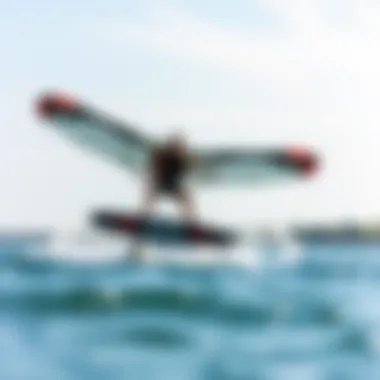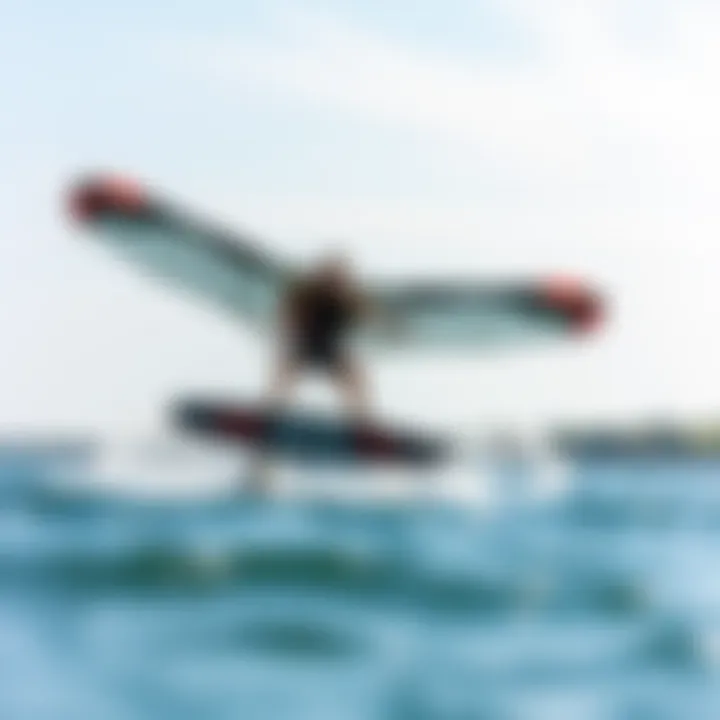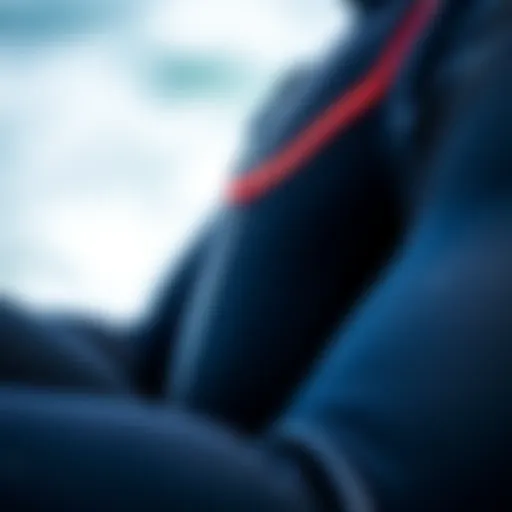Mastering the Wingfoil Wing: A Complete Guide


Intro
When it comes to kiteboarding, few things are as exhilarating as gliding across the water with the help of a wingfoil wing. The feel of the wind on your face as you maneuver effortlessly over the waves brings an unmatched thrill. Understanding the intricacies of wingfoil wings is essential for anyone wanting to optimize their kiteboarding experience. This guide will break down phenomena surrounding wingfoil wings, from the latest gear insights to riding techniques that can elevate this sport to new heights.
Wingfoiling has been growing rapidly in popularity among water enthusiasts. Its unique design and functionality not only enhance performance but also redefine what’s possible with kiteboarding. Whether you’re a seasoned pro or just getting your feet wet, grasping the basics of this innovative gear ensures you’re well-prepared to tackle the challenges and excitement that come with it. Let's dive right in and explore the aspects that make these wings so crucial in the kiteboarding realm.
Gear Insights
Latest Gear Reviews
In today’s market, the sheer variety of wingfoil wings can be a bit overwhelming. There’s always something new on offer, and distinguishing quality from subpar options is no easy feat. Some standout options currently making waves include the Duotone Echo and the Naish S25. Both these models boast superior durability and performance.
- Duotone Echo: Known for its stiffness, the Echo provides excellent control and responsiveness, which is particularly beneficial for maneuvering at high speeds.
- Naish S25: With a balanced aspect ratio, the S25 offers tremendous lift, making it easier for riders to get up on the foil without excessive effort.
Reading reviews on sites like reddit.com or manufacturer websites can give you more insight into individual experiences. Remember that gear preferences often depend on personal riding style, so don’t shy away from trying out different wings whenever possible.
Essential Gear for Beginners
For those just dipping their toes into wingfoiling, selecting the right gear can lay a solid foundation for your progression. Here are a few essentials:
- A Beginner Wing: Opt for a wing with a lower aspect ratio which offers better stability at slower speeds.
- A Foil Setup: Look for a setup that provides a steady ride; larger wings typically yield a more stable experience for novices.
- Safety Equipment: Don’t scrimp on safety gear. A helmet, impact vest, and a personal flotation device (PFD) are must-haves.
With the right gear in hand, you’ll reduce the steepness of your learning curve and get to experience the joys of wingfoiling sooner.
"Wingfoiling isn't just about the gear you have, but how you learn to control it that truly matters."
Techniques and Tips
Riding Techniques
As you gain confidence on your wingfoil, expanding your repertoire of techniques and tricks becomes essential. Each maneuver requires practice, so it’s crucial to start slow and build upon your skills. Here are a few techniques to consider:
- Pump Technique: Mastering the pump allows for acceleration without relying entirely on wind strength. Use your legs and core for powerful, rhythmic movements to maintain speed and lift.
- Tack and Jibe: Learning how to perform tacks and jibes will enable you to change direction smoothly. Work on keeping your weight balanced and your eyes focused on the intended path.
- Transitions: Getting from one side to the other can seem tricky. Practice your foot placements and body movements—this will help facilitate smoother transitions as you ride.
Safety Practices for Kiteboarders
Safety cannot be overstated in this thrilling sport. Familiarize yourself with the following best practices to ensure your experience remains enjoyable:
- Always check the weather conditions before heading out. Wind strength and sea state can change rapidly.
- Take note of your surroundings, especially other riders. Awareness of who’s around you helps prevent accidents.
- Learn to self-rescue; knowing how to handle equipment malfunctions can be the difference between a smooth ride and a troublesome situation.
The future of wingfoiling is bright, making it undoubtedly a discipline to embrace in your adventures.
Preamble to Wingfoiling
Wingfoiling is a relatively new addition to the world of water sports, merging elements of surfing, kitesurfing, and windsurfing into one exhilarating experience. As we explore the intricacies of wingfoiling, it is essential to grasp why it holds significance for both beginners and seasoned riders alike. This section serves as a gateway into understanding the fundamentals of wingfoiling, emphasizing the benefits and unique considerations that come with this dynamic activity.
One of the most appealing aspects of wingfoiling is its accessibility. Unlike traditional kitesurfing, where one must wrestle with heavy equipment to get started, wingfoiling offers a lighter, more intuitive form of riding. With a wing that simply needs to be held aloft, riders can glide across the water at their own pace, adjusting their stance and balance with relative ease. This simplicity attracts a diverse group of enthusiasts, from those who casually enjoy the sport to those looking for the adrenaline rush that comes with higher speeds.
Moreover, the minimalistic nature of wingfoiling equipment makes it easier for travelers and adventure seekers. Unlike bulky setups that can dominate your luggage, wingfoiling gear is typically compact and manageable. A single wing, a board, and a foil can fit into a car trunk or even a backpack, making it an ideal choice for those who wish to explore different bodies of water around the globe.
As we delve deeper into each aspect of wingfoiling, it becomes clear that understanding the core principles is imperative. From the design and functionality of the wing to the techniques that will enhance your riding experience, this guide aims to equip you with the knowledge necessary to not just ride but thrive in the world of wingfoiling.
There’s a lot to cover, so let's get started.
Definition of Wingfoiling
Wingfoiling, at its essence, can be defined as a water sport that involves riding on a board while holding a wing to catch the wind. This combination allows for an experience that's unique to other wind-powered sports. The wing itself is not anchored to the board but is held by the rider, providing an element of freedom that many find exhilarating. In simpler terms, it's like standing on a surfboard with a wind sail, but the way these elements interact creates a completely different ride.
The board used in wingfoiling is often a smaller and more buoyant than a traditional paddleboard, specifically designed to be used with a hydrofoil underneath. This hydrofoil lifts the board above the water's surface when moving, reducing drag significantly. The result? A smooth glide that feels almost like flying, offering a distinct sensation that captures the imagination of those fortunate enough to experience it.
Historical Context
The concept of wingfoiling has historical roots that can be traced back to the development of both foiling and wing design in water sports. However, it wasn't until recent years that these ideas coalesced into the cohesive sport we see today. The combination of the hydrofoil and wind-powered wing began to gain traction in the early 2010s, with early inventors and enthusiasts experimenting with different designs.
Over time, advancements in materials and design brought forth lighter weights, improved durability, and enhanced performance. By the mid-2010s, the wing was no longer just an experiment; it was becoming clear that wingfoiling was here to stay. Events and competitions have popped up globally, showcasing this exciting discipline and solidifying its place in the water sports community.
As wingfoiling continues to grow, it brings along a community rich in passion and a culture eager to share experiences. The sport embodies the freedom of the open water, and understanding its history offers valuable insights into its future and the innovative spirit behind it. Reflecting on its evolution helps riders appreciate the incredible strides made in both design and performance that enhance their experience on the water.
Components of the Wingfoil
When it comes to wingfoiling, understanding the various components of the wingfoil is paramount. Each part has a unique role that contributes to the performance and efficiency of the entire setup. Think of it like a well-oiled machine; if one cog is out of place, the whole system might falter. Let's break down the main elements that form what we know as the wingfoil.
Wing Design
The wing design is arguably the heart of the wingfoil system. Many aspects come into play here, including the wing's shape, size, and material. For instance, a larger wing offers greater lift, making it suitable for lighter winds or beginners. In contrast, smaller wings cater to experienced riders who can harness speed and agility on the water.
Additionally, the aspect ratio—the ratio of the wing's span to its chord—plays a crucial role in how the wing behaves. A higher aspect ratio generally provides better glide and efficiency, acting like a bird in flight. On the other hand, lower aspect ratios tend to be more stable, which might suit those just starting their wingfoiling adventure.
The leading edge is another factor. It must be robust enough to withstand impact yet flexible enough to adapt to different wind conditions. Materials like ripstop nylon or mylar are common, offering durability without compromising performance. In essence, understanding the design intricacies can make or break your experience on the water.


Mast and Foil Attachment
This component, often overlooked, is crucial for any serious rider. The mast serves as the backbone, connecting the wing to the hydrofoil beneath. The connection must be solid; otherwise, you'll find yourself in a precarious situation when the wind picks up or when you attempt to maneuver. Different setups exist, such as removable masts or integrated systems, and each has its pros and cons.
The foil attachment point also deserves your attention. It's vital that this connection is seamless and maintains the correct angle to avoid any unwanted resistance during movement. Some setups come with adjustable screws, allowing for fine-tuning based on your riding style and conditions. This ability to customize can lead to significant performance gains.
"A poorly attached foil will rob you of efficiency and enjoyment on the water. Get this step right to ensure a smooth ride."
Inflation System
An often underestimated yet highly important component is the inflation system. Most modern wingfoils employ an inflating mechanism that sets them apart from rigid wings. This design has made transporting and storing much easier. The inflation process can generally be handled with ease, using electric or manual pumps depending on your preference and urgency.
Different wings may employ varying inflation systems. Some utilize one single inflation chamber while others may employ multiple chambers for added security. This multi-chamber design can provide buoyancy even if one chamber becomes compromised. When it comes to choosing a wingfoil, consider this element carefully. Safety cannot be overstated.
In summary, understanding the components of the wingfoil will not only enhance your riding experience but also equip you with the knowledge to make intelligent choices when selecting gear. The right wing design, a sturdy mast and foil attachment, and a reliable inflation system are all integral parts of this exciting discipline.
Material Considerations
When it comes to wingfoiling, understanding the materials that compose your gear is essential. The right material selection can significantly influence performance, durability, and overall experience on the water. In this section, we'll dive into the specifics of fabric types used in wingfoils and weigh the considerations between durability and weight.
Fabric Types
The fabrics used in wingfoil wings vary widely, affecting everything from how the wing performs during flight to its longevity. Common materials include polyester, ripstop nylon, and even specialized blends designed for enhanced performance.
- Polyester is often favored for its excellent resistance to UV light and abrasion, making it suitable for long days on the water. It's a robust material but can be heavier compared to others.
- Ripstop Nylon is lighter and tends to be more flexible, offering great maneuverability and responsiveness. It’s particularly advantageous for those who enjoy dynamic riding styles.
- Some newer fabrics incorporate Mylar or laminated materials, which boast an even lower weight while maintaining stiffness, enhancing lift and glide efficiency.
For instance, a wing made from ripstop nylon might feel lightweight and playful, giving a rider the ability to change direction with ease, whereas a polyester wing might lend itself to stability and predictability in larger waves.
Choosing the right fabric is not merely about preference—it's about understanding the type of riding you'll engage in.
Durability vs. Weight
The battle between durability and weight is often a significant consideration for wingfoiling enthusiasts. Riders need to strike a balance based on their skill level and typical riding conditions.
- Durability Higher durability materials can withstand harsh conditions and the wear and tear from rough water. This is crucial for beginners who may often tumble in the water or for those who ride in rocky conditions. However, these materials can add extra pounds, which might inhibit agility.
- Weight On the contrary, lighter materials enhance performance—making it easier to catch winds and perform tricks. However, they may also be more susceptible to damage. An advanced rider may prefer a featherlight wing that enhances performance, while a novice would benefit from a sturdier model.
Ultimately, every rider has a unique relationship with their gear. Some may lean toward a sturdy wing that can endure tough conditions, while others may yearn for lightness to maximize performance.
"When considering materials, it’s vital to align your choices with your personal riding style and prevailing conditions. Choices made today can shape your experiences for seasons to come."
In closing, acknowledging the importance of material considerations can elevate one’s wingfoiling adventures. Skimping on quality can lead to untold frustrations down the line, while the right gear can make you feel like you're flying.
For further insights on material properties and comparisons, visit resources like Wikipedia and check forums on Reddit for firsthand accounts of what different fabrics feel like during use.
Choosing the Right Wing
Selecting the appropriate wing for wingfoiling is crucial, as it fundamentally affects your performance on the water. Because every rider's needs differ, it’s not just about getting any wing off the rack. The right wing enhances your experience, boosts your control, and can either promote or hinder your progress as a rider.
Several specific elements need consideration in this selection process, from size to environmental factors. Understanding how these aspects meld together can drastically change your ride and help you fully embrace the thrill of wingfoiling.
Size and Volume Considerations
When it comes to wing size, it's all about balance. A larger wing generates more lift, making it easier for beginner riders to get up on the foil. But what about experienced riders? They might lean towards a smaller wing that offers higher speeds and better maneuverability. When you’re assessing size, consider your weight and skill levels.
- Beginners: If you’re around 150 pounds, wings in the 5 to 6-meter range can provide the necessary lift.
- Advanced Riders: Weighing about 190 pounds? Opting for a 4 to 5-meter wing may give you the thrill and responsiveness you crave.
Moreover, don’t neglect the volume of the wing. The volume affects the stability and responsiveness, which directly influences how you ride. Smaller wings may provide swifter turns, allowing ride enthusiasts to express their creativity.
The right size significantly affects your control, response times, and overall enjoyment on the water, making this aspect a priority in your decision-making.
Skill Level and Wing Type
When choosing your wing, be real with yourself about your riding skills. Understanding your comfort level will steer you toward the right wing type. Various types cater to different skill levels:
- All-around Wings: Ideal for beginners and intermediate riders; offers versatility in various conditions.
- Freestyle Wings: Perfect for advanced riders looking to perform tricks and spins in moderate wind.
- Racing Wings: They enhance speed and are generally suited for expert riders who thrive in competitive environments.
Selecting the right wing type can significantly expand your capabilities or provide the foundation to hone your skills. Pick something that complements your style while pushing your boundaries without throwing you off balance.
Conditions and Environment
Environmental factors play a pivotal role in choosing the right wing. The wind conditions and water state will guide your choice.
- Light Wind Days: Larger wings are your friends. They offer the lift and stability needed to get going when breezes are soft.
- Heavy Wind Days: A smaller wing can help minimize excessive lift and maintain control without getting tossed about.
Wrapping It All Up
In summary, taking the time to choose the right wing combines knowing your own needs, understanding the technical facets of the wings available, and being aware of your environment. It’s not simply about what looks good; it’s about how it feels when you're out there in the elements, gliding over the water.
Useful Resources:


Taking all these considerations into account helps tailor the gear to the rider's unique needs, setting the stage for a more liberated, engaged, and ultimately enjoyable wingfoiling experience. Making the selection thoughtfully can greatly influence your journey in this thrilling sport.
Performance Features
In wingfoiling, performance features play a crucial role in how effectively a rider can harness the wind and glide across the water. Understanding these features can set you apart from the rest, unlocking not just thrilling rides but also safety and efficiency. Key elements like lift, glide efficiency, control, and stability directly impact your experience on the water. Whether you’re slicing through waves or cruising with the breeze, knowing these factors inside and out fosters a deeper connection between you and your equipment.
Lift and Glide Efficiency
Lift and glide efficiency go hand in hand; they are the bread and butter of wingfoiling. Ideally, a well-designed wing allows riders to achieve greater lift with minimal effort. This is particularly important, especially for beginners who need all the help they can get to rise above the surface. High lift means that you don’t have to work as hard to get the board in the air, enabling longer rides and less energy expenditure.
- Wing Shape: A wing's shape significantly influences lift capabilities. For example, a higher aspect ratio typically offers improved lift-to-drag ratio, while a more rounded shape tends to provide better stability at low speeds.
- Angle of Attack: Adjusting the angle of attack on your wing can directly enhance lift, letting you fine-tune your performance based on prevailing wind conditions.
Ultimately, a wing that excels in lift and glide efficiency will allow you to tap into the power of the wind with finesse. This synergy not only boosts your confidence but also enhances the overall enjoyment of the sport.
Control and Stability
Control and stability are vital for a smooth ride, especially when tackling rough waters or unpredictable winds. A stable wing does not only contribute to your comfort but also ensures your safety as you navigate various conditions. Poor control can lead to mishaps, which is the last thing you want while enjoying your time on the water.
- Wing Design Factor: The design inherently influences control. Wings with a wider span tend to have a greater surface area, allowing for better stability during maneuvers but may sacrifice some speed. Conversely, a narrower wing will be faster but could compromise stability.
- Weight Distribution: Pay attention to how body weight interacts with your wing and foil setup. Proper weight distribution helps maintain balance, especially during dynamic moves or when shifting body weight.
Control stems from a well-balanced combination of wing design and rider technique. As you grow in skill, understanding how your muscle memory interacts with the equipment will enhance your ability to maneuver confidently.
In summary, focusing on lift, glide efficiency, control, and stability will significantly enhance your riding quality. Pay attention to these performance features, and you'll find that mastery over your wingfoil creates an unmatched experience.
These features are not just technical aspects; they represent the very essence of what makes riding a wingfoil exciting and rewarding. Make it a point to study and practice these principles, ensuring that every ride is not just an activity but a journey into the exhilarating world of wingfoiling.
Riding Techniques
Riding techniques are the backbone of mastering wingfoiling. It’s not just about how you hold the wing or balance on the board; it's about adapting to the dynamic nature of the environment and using your body and equipment to harness the wind effectively. Having a solid foundation in riding techniques can elevate your experience, enabling you to navigate through rough waters and perform impressive maneuvers. Understanding these techniques is crucial for safety, efficiency, and enjoyment on the water.
Getting Started: Basic Stances
When you first start wingfoiling, nailing down your stance is key. The right stance ensures balanced riding and effective movement of the wing.
- Feet Positioning: Place your feet shoulder-width apart on the board. This stance helps maintain stability. Your back foot should slightly overlap the tail of the board, allowing for better control when steering.
- Flex Your Knees: Bend your knees a bit. This lowers your center of gravity and improves balance. You want to feel relaxed yet ready to adjust at a moment's notice.
- Wing Grip: Hold the wing with both hands, evenly spaced apart. Keep your elbows slightly bent, which enables easier control of the wing's angle according to wind direction.
- Body Alignment: Keep your body facing forward, looking toward where you want to go. This promotes quicker reactions and smoother transitions between maneuvers.
"Your stance is like the foundation of a house; if it ain’t solid, everything else just crumbles."
Starting with these basics allows you to build confidence. It also sets the stage for learning advanced techniques as you gain more experience.
Advanced Maneuvers
Once you’ve gotten your footing — quite literally — it’s time to level up. Advanced techniques take time but can really impress your friends or fellow enthusiasts at the beach.
- Tacking: This involves switching directions smoothly. Lean into the turn while shifting your weight from one leg to the other. It’s a skill that lets you ride back into the wind, keeping you out longer.
- Jibing: Similar to tacking but you will steer downwind. As you pivot, listen to how the wind shifts in your sail. Your body should turn with your board; think of it like a dance.
- Jumping: Yes, you can catch some air! To achieve this, build speed, press down with your back foot while pulling up with the wing. Commit to it, but don’t overexert yourself the first several times.
- Transitions: Perfecting transitions can help you flow from one riding style to another. Go from a regular stance to a toeside stance by subtly shifting your weight while adjusting the wing position.
Mastering these maneuvers takes patience. Not every attempt will land exactly how you envision it, but as you practice, you'll get closer to that effortless glide and the thrill that comes with it.
Safety Considerations
When it comes to wingfoiling, making safety a top priority is vital. Engaging in this sport can be thrilling, but it can also come with inherent risks. Ensuring that both novice and seasoned riders remain safe while enjoying the wind and water is essential for fostering a positive experience within this community. This section dives deep into the significance of precautionary measures, guiding enthusiasts through a pre-ride checklist and offering strategies to avoid injuries.
Pre-Ride Checklist
Before even thinking about hitting the water, every rider should run through a comprehensive pre-ride checklist. This list acts as a safeguard, minimizing potential problems and keeping riders prepared for the unexpected. Here’s what to include:
- Equipment Inspection: Make sure your wing, mast, and foil are in good working order. Look for tears, leaks, and any corrosion. Also check for any signs of wear that may have crept in since your last session.
- Safety Gear: Always wear a personal flotation device (PFD). Helmets are also recommended. Don’t skimp on safety; it’s worth your neck.
- Wind and Water Conditions: Check local forecasts to understand wind speeds, currents, and tides. Remember that conditions can change rapidly, and what might seem safe could quickly turn chaotic.
- Emergency Plan: Have a plan in case things go south. Know where you’ll head if you run into trouble, whether that be returning to shore or signaling for help.
- Buddy System: If you can, never go out alone. Having someone nearby can make a huge difference.
Injury Prevention Strategies
Injuries in wingfoiling can range from mild to severe, but the good news is that many can often be prevented with the right strategies. Here are key points to consider that contribute to riding safely:
- Proper Technique: Learning to ride properly can dramatically reduce the likelihood of falls and injuries. Take lessons if you can; investing in a good instructor can pay dividends long term.
- Stay Within Your Skill Level: It’s tempting to push your limits, but knowing what you can handle is crucial. If the conditions seem above your capability, sit it out. It’s not worth risking injury.
- Warm Up and Stretch: Preparing your body for the exertion ahead is paramount. Stretching can increase flexibility and strength, giving you a better range of motion on the water.
- Maintain Clear Awareness: Always keep an eye out for other riders, obstacles, and changing weather patterns. Distraction can lead to accidents, so stay focused on your surroundings.
Safety doesn’t happen by accident; it’s the result of careful planning and consideration.
With the insights offered in these sections, both novice and experienced riders will be better equipped to tackle the exciting world of wingfoiling, with a strong emphasis on safety!
For further resources on safety and techniques in water sports, consider visiting REI or The American Red Cross.
Maintenance and Care
Keeping your wingfoil kit in tip-top shape is not just about aesthetics; it fundamentally affects performance and longevity. Like a well-oiled machine, proper maintenance ensures that every session is not just enjoyable but safe. Nobody likes the feeling of hitting the water only to realize that their equipment is not up to par. Investing a little time into maintenance can yield substantial benefits, such as enhanced performance, prolonged lifespan, and improved overall safety.
Cleaning Procedures
After a rigorous day of riding the waves, it's essential to give your wingfoil a good cleaning. Sand, salt, and grime can build up fast, and if left unaddressed, they can lead to premature wear and tear. Here are some steps you might consider:
- Rinse with Fresh Water: After every session, rinse the wing with fresh water. Use a hose or bucket to ensure all salt and sand are washed away thoroughly.
- Gentle Scrubbing: For stubborn dirt, employ a soft brush or a sponge. Steer clear of abrasive materials that could scratch the surface.
- Drying: Always hang your wing to dry in a shaded area. Direct sunlight can weaken the fabric over time, so letting it air dry is a safer bet.
"A little care goes a long way; treat your gear well, and it will reward you on the water."


Storage Tips
Once your wingfoil is clean and dry, it’s time to think about storage. Proper storage is crucial to prevent damage when you’re not using your equipment. Here’s how to stow away your gear:
- Use a Bag: Invest in a suitable bag for your wing. A dedicated wing bag provides crucial protection against nicks and tears.
- Avoid Overpacking: Don't cram too much into your storage bag. Excess pressure could deform the wing shape, which would hinder performance.
- Store in a Dry Place: Humidity can lead to mold and mildew, so keep your gear in a dry environment. A temperature-controlled space is preferable for longevity.
- Avoid Direct Heat Sources: Don't store your gear near heaters or in the trunk of your car under the sun, as extreme temperatures can warp materials.
The Future of Wingfoiling
As the world of watersports continues to evolve, wingfoiling is carving out its own niche with growing popularity. This section delves into what we can expect in the future of this thrilling sport, focusing on how technological advancements and emerging trends are shaping the experience for kiteboarders and water enthusiasts. With a spotlight on innovation, we will explore how these developments can enhance performance, safety, and accessibility, ensuring that wingfoiling remains an exhilarating pursuit for all.
Technological Innovations
The impact of technological innovations on wingfoiling is nothing short of transformative. Manufacturers are continuously seeking ways to enhance equipment performance through better materials, smarter designs, and even integrating smart technology. For instance, the advent of lighter, stronger fabrics has allowed for wings that are easier to handle while also providing better lift and stability. This shift isn't just about the wing itself; it extends to foils and masts as well, with advancements in hydrofoil design improving glide efficiency and reducing drag.
Additionally, we are starting to see the introduction of digital interfaces that provide real-time data such as speed, wind direction, and even battery levels for electric foil setups. These technologies are enabling riders to fine-tune their performance dynamically, leading to safer and more effective riding experiences. One can also envision personalized coaching algorithms being developed that leverage data analytics to help riders at all levels improve their skills effectively.
Key Innovations to Look Out For:
- Advanced Fabric Technology: New materials that enhance durability while being lightweight.
- Smart Wing Designs: Integrated sensors providing live feedback on performance metrics.
- Eco-friendly Production: A trend towards sustainable materials in manufacturing processes.
"Innovation is the mother of necessity. As the sport evolves, so too do the demands on the technology behind it."
Emerging Trends in the Sport
The landscape of wingfoiling is witnessing several emerging trends that are likely to define its future. One noticeable shift is the rising popularity of wingfoiling in a variety of settings, from urban lakes to oceanic waterways. As more enthusiasts take to the water, we’re seeing a push for more community events and competitions, encouraging collaboration and camaraderie among riders.
There is also a clear trend towards accessibility. Equipment is becoming easier to transport and set up, which lowers the barrier to entry for newcomers. Entry-level wings are designed with forgiving characteristics to help less experienced riders develop their skills without frustration. This promise of accessibility is vital in attracting a broader audience, making the sport more inclusive.
Moreover, the blending of various watersport disciplines is noteworthy. Many traditional kiteboarders are adopting wingfoils, and vice versa. This crossover not only invigorates the communities but also enhances the skill sets of riders. Equipment companies are responding with versatile products that cater to this blended market, offering wings that can perform well across different types of riding.
Trends Worth Watching:
- Community Growth: More local meet-ups and competitive opportunities.
- Cross-disciplinary Riding: Increased interchange between wingfoiling, kitesurfing, and surfing.
- Sustainable Practices: A growing movement towards eco-conscious manufacturing and riding practices.
The future of wingfoiling appears bright, filled with potential for innovation and inclusivity. It’s imperative that enthusiasts remain informed about these changes, as they will undoubtedly shape the way the sport is enjoyed in the years to come. For the latest updates, forums like Reddit's Wingfoil community and dedicated events can be great resources for staying engaged with the sport.
Community and Resources
In the world of wingfoiling, community engagement and resource availability are fundamental for enthusiasts and newcomers alike. Connecting with others who share similar interests can greatly enhance learning and development in the sport. This section highlights the significance of community involvement and the available resources that cater to kiteboarders, instructors, and hobbyists looking to deepen their understanding of wingfoiling.
Online Forums and Groups
The rise of digital communication has transformed how riders share experiences and gain knowledge. Online forums and social media groups revolve around wingfoiling, providing a platform for discussions on various aspects, from gear selection to riding tips. Members of these groups often share personal anecdotes, successes, and missteps, creating a supportive environment that fosters growth.
Some popular platforms include:
- Reddit: The r/wingfoiling subreddit is a treasure trove of discussions, ranging from beginner questions to advanced techniques.
- Facebook Groups: Groups like "Wing Foiling Community" allow members to share photos, videos, and ideas, creating a vibrant online space.
- Dedicated Websites: Sites featuring forums can offer archived discussions that delve into product reviews and technique critiques.
The benefits of participating in these forums are vast. Not only can newcomers ask questions and receive real-time feedback, but they can also discover local riders and events through shared posts. This lightens the learning curve and enhances the enjoyment of wingfoiling.
Local Events and Competitions
Attending local events and competitions can provide invaluable hands-on experience and exposure to the wingfoiling community. These gatherings are not just about competition; they offer a chance to learn from seasoned riders and engage with various brands and products.
Some key elements include:
- Workshops: Many events host workshops that cover everything from basics to advanced maneuvers, catering to all skill levels.
- Networking Opportunities: Meeting fellow riders can lead to lasting friendships and partnerships in the sport. Whether for camaraderie during rides or for sharing lessons learned, the connections you forge at these events can open doors.
- Competition: Participating in or watching competitions sharpens skills and demonstrates the latest techniques and styles, inspiring attendees to elevate their own riding.
Involvement in local events can also strengthen the sense of community. The shared excitement and adrenaline from competing or supporting fellow riders creates a kinship that is hard to replicate elsewhere. From beach cleanups to demo days, getting involved can also lead to a more sustainable experience within wingfoiling.
"Connection is the heart of community; it fuels the passion for wingfoiling and elevates the entire experience."
By tapping into these resources, both online and offline, riders can continually grow their skills, expand their knowledge, and foster lasting relationships within the wingfoiling community.
Finale
As we bring our exploration of wingfoiling to a close, it’s essential to synthesize the elements that make this sport not just a pastime but a thrilling adventure. Understanding the intricacies of wingfoiling is vital for both newcomers and seasoned riders, as it opens doors to the community, enhances riding techniques, and heightens the overall experience.
Summarizing Key Insights
Throughout this guide, we have dissected various aspects of wingfoiling that are paramount to your engagement in the sport. Key insights include:
- Understanding Wing Design: Recognizing how different shapes and sizes impact your lift and control can vastly affect your performance on the water.
- Adaptability to Conditions: Tailoring your wing choice based on the wind, waves, and water surface can vastly enhance your riding experience, making it not just enjoyable but also safer.
- Safety First: Emphasizing the importance of pre-ride checklists and injury prevention techniques is not only wise; it’s essential. A safe rider is a happy rider.
- Community Connection: Engaging with local riders and online forums fosters a supportive environment that reinforces learning and growth.
Each point feeds into the larger narrative of what wingfoiling represents—an exhilarating pursuit that bridges the gap between nature and sport.
Final Thoughts on Wingfoiling
In the end, wingfoiling stands at the crossroads of innovation and tradition within the kiteboarding universe. It invites adventure seekers to harness the wind and water, providing a unique blend of skill and enjoyment. As technology advances, the possibilities for evolving gear and techniques are boundless. Riders are now looking beyond the gear; they're embracing the culture, the friendships forged at the beach, and the exhilarating freedom that comes with mastering the wind.
Whether you are just dipping your toes into the world of wingfoiling or you’re already riding the waves, the key takeaway is to stay curious. Keep picking up skills, engaging with the community, and enjoying every breeze you encounter.
"The journey of wingfoiling is not just about the destination; it’s about mastering the nuances of the ride and savoring each wave."
For more insights, consider joining discussions at Reddit or checking local events through Facebook.
Embrace the adventure before you, and let the wind guide you!















